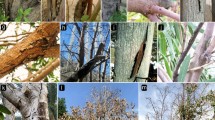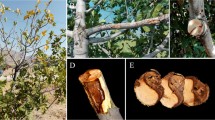Abstract
Dieback and canker diseases are a major problem in ornamental shrubs and trees of Ahvaz, southwestern Iran. Symptomatic stems and branches were collected from two urban parks in the downtown regions of Ahvaz to identify the dieback-causing agents of Lantana camara. Accordingly, two isolates of a new species, Allophoma hayatii sp. nov., were obtained, which are described and illustrated. This species is identified based on morphological characters and analyses of nucleotide sequences of four regions, including internal transcribed spacer 1 and 2 and 5.8S nrDNA (ITS), partial large subunit 28S nrDNA (LSU-D1/D2), a partial sequence of the β-tubulin (tub2) and part of the RNA polymerase II (rpb2). The isolates of A. hayatii generated a well-supported clade in the trees constructed from multi-locus phylogenetic analysis, distinct from other previously known species of Allophoma. Pathogenicity of both isolates was verified by the inoculation of stem fragments of L. camara. These findings confirm A. hayatii as the causal agents of dieback and canker of L. camara in Ahvaz.





Similar content being viewed by others
References
Abdollahzadeh J, Zare R, Phillips AJL (2013) Phylogeny and taxonomy of Botryosphaeria and Neofusicoccum species in Iran, with description of Botryosphaeria scharifii sp. nov. Mycologia 105:210–220
Ahmadpour SA, Mehrabi-Koushki M, Farokhinejad R (2017) Neodidymelliopsis farokhinejadii, a new fungal species from dead branches of trees in Iran. Sydowia 69:171–182
Álvarez LA, Armengol J, Pérez-Sierra A, León M, Abad P, Vicent A, García-Jiménez j, Beltrán C (2005) First report of Phoma exigua var. heteromorpha causing oleander dieback in Spain. Plant Dis 89:775. https://doi.org/10.1094/PD-89-0775B
Ariyawansa HA, Hyde KD, Jayasiri SC et al (2015) Fungal diversity notes 111–252—taxonomic and phylogenetic contributions to fungal taxa. Fungal Divers 75:27–274
Arnold AE, Herre EA (2003) Canopy cover and leaf age affect colonization by tropical fungal endophytes: ecological pattern and process in Theobroma cacao (Malvaceae). Mycologia 95:388–398
Aveskamp MM, de Gruyter J, Crous PW (2008) Biology and recent developments in the systematics of Phoma, a complex genus of major quarantine significance. Fungal Divers 31:1–18
Aveskamp MM, Verkley GJM, de Gruyter J, Murace MA, Perello A, Woudenberg JHC, Groenewald JZ, Crous PW (2009a) DNA phylogeny reveals polyphyly of Phoma section Peyronellaea and multiple taxonomic novelties. Mycologia 101:363–382
Aveskamp MM, Woudenberg JHC, de Gruyter J, Turco E, Groenewald JZ, Crous PW (2009b) Development of taxon-specific sequence characterized amplified region (SCAR) markers based on actin sequences and DNA amplification fingerprinting (DAF): a case study in the Phoma exigua species complex. Mol Plant Pathol 10:403–414
Aveskamp MM, de Gruyter J, Woudenberg JHC, Verkley GJM, Crous PW (2010) Highlights of the Didymellaceae: a polyphasic approach to characterise Phoma and related pleosporalean genera. Stud Mycol 65:1–60
Beneke ES, Rogers AL (1996) Medical mycology and human mycoses. Star Publishing Company, Belmont, 239 pp
Boerema GH (1993) Contributions towards a monograph of Phoma (Coelomycetes)—II. Section peyronellaea. Persoonia 15:197–221
Boerema GH, de Gruyter J, Noordeloos ME, Hamers MEC (2004) Phoma identification manual. Differentiation of specific and infra-specific taxa in culture. CABI Publishing, Wallingford
Botella L, Santamaría O, Diez JJ (2010) Fungi associated with the decline of Pinus halepensis in Spain. Fungal Divers 40:1–11
Brewer MT, Rath M, Li HX (2015) Genetic diversity and population structure of cucurbit gummy stem blight fungi based on microsatellite markers. Phytopathology 105:815–824
Cannon PF, Damm U, Johnston PR, Weir BS (2012) Colletotrichum—current status and future directions. Stud Mycol 73:181–213
Chen Q, Jiang JR, Zhang GZ, Cai L, Crous PW (2015) Resolving the Phoma enigma. Stud Mycol 82:137–217
Chen Q, Hou LW, Duan WJ, Crous PW, Cai L (2017) Didymellaceae revisited. Stud Mycol 87:105–159
Crous PW, Schumacher RK, Wingfield MJ, Lombard L, Giraldo A, Christensen M, Gardiennet A, Nakashima C, Pereira OL, Smith AJ, Groenewald JZ (2015) Fungal systematics and evolution: FUSE 1. Sydowia 67:81–118
de Gruyter J (2002) Contributions towards a monograph of Phoma (Coelomycetes)—IX. Section Macrospora. Persoonia 18:85–102
de Gruyter J, Noordeloos ME (1992) Contributions towards a monograph of Phoma (Coelomycetes)—I. 1. Section Phoma: Taxa with very small conidia in vitro. Persoonia 15:71–92
de Gruyter J, Noordeloos ME, Boerema GH (1993) Contributions towards a monograph of Phoma (Coelomycetes)—I. 2. Section Phoma: additional taxa with very small conidia and taxa with conidia up to 7 μm long. Persoonia 15:369–400
de Gruyter J, Aveskamp MM, Woudenberg JHC, Verkley GJM, Groenewald JZ, Crous PW (2009) Molecular phylogeny of Phoma and allied anamorph genera: towards a reclassification of the Phoma complex. Mycol Res 113:508–519
de Gruyter J, Woudenberg JHC, Aveskamp MM, Verkley GJM, Groenewald JZ, Crous PW (2010) Systematic reappraisal of species in Phoma section Paraphoma, Pyrenochaeta and Pleurophoma. Mycologia 102:1066–1081
de Gruyter J, Woudenberg JHC, Aveskamp MM, Verkley GJM, Groenewald JZ, Crous PW (2012) Redisposition of phoma-like anamorphs in Pleosporales. Stud Mycol 75:1–36
Desprez-Loustau ML, Robin C, Reynaud G, Déqué M, Badeau V, Piou D, Husson C, Marçais B (2007) Simulating the effects of a climate-change scenario on the geographical range and activity of forest-pathogenic fungi. Can J Plant Pathol 29:101–120
Druzhinina IS, Kubicek CP, Komoń-Zelazowska M, Mulaw TB, Bissett J (2010) The Trichoderma harzianum demon: complex speciation history resulting in coexistence of hypothetical biological species, recent agamospecies and numerous relict lineages. BMC Evol Biol 10:94–96
Ershad D (2009) Fungi of Iran, 3rd edn. Iranian Research Institute of Plant Protection, Tehran
Garampalli RH, Gapalkrishna MK, Li HX, Brewer MT (2016) Two Stagonosporopsis species identified as causal agents of gummy stem blight epidemics of gherkin cucumber (Cucumis sativus) in Karnataka, India. Eur J Plant Pathol 145:507–512
Garibaldi A, Gilardi G, Ortu G, Gullino ML (2012) First report of leaf spot of lettuce (Lactuca sativa L.) caused by Phoma tropica in italy. Plant Dis 96:1380
Hall TA (1999) BioEdit: a user-friendly biological sequence alignment editor and analysis program for Windows 95/98/NT. Nucleic Acids Symp Ser 41:95–98
Hembram S, Baskey S (2015) Interaction of different pathogens on the extent of lesion development of betelvine (piperis betle). Int J Recent Sci Res 6:7162–7165
Henricot B (2012) Occurence of Boeremia exigua var heteromorpha on Nerium oleander in the United Kingdom. New Dis Rep 26:20
Hyde KD, Nilsson RH, Alias SA et al (2014) One stop shop: backbones trees for important phytopathogenic genera: I. Fungal Divers 67:21–125
Hyde KD, Hongsanan S, Jeewon R et al (2016) Fungal diversity notes 367–490: taxonomic and phylogenetic contributions to fungal taxa. Fungal Divers 80:1–270
Jayawardena RS, Hyde KD, Damm U, Cai L, Liu M, Li XH, Zhang W, Zhao WS, Yan JY (2016) Notes on currently accepted species of Colletotrichum. Mycosphere 7:1192–1260
Khatua DC, Bhattacharya R (2015) Xanthomonas axonopodis pv. betlicola: its epiphytic survival and association with other fungal pathogens of betelvine. Int J Bio-Resource Environ Agric Sci 1:59–64
Kim KW, Lee IJ, Thoungchaleun V, Kim CS, Lee DK, Park EW (2009) Visualization of wound periderm and hyphal profiles in pine stems inoculated with the pitch canker fungus Fusarium circinatum. Microsc Res Tech 72:965–973
Kornerup A, Wanscher JH (1967) Methuen handbook of colour. Methuen & Co. Ltd, London
Laurence MH, Summerell BA, Burgess LW, Liew ECY (2014) Genealogical concordance phylogenetic species recognition in the Fusarium oxysporum species complex. Fungal Biol 118:374–384
Li GJ, Hyde KD, Zhao RL et al (2016) Fungal diversity notes 253–366: taxonomic and phylogenetic contributions to fungal taxa. Fungal Divers 78:1–237
Liu YJ, Whelen S, Hall BD (1999) Phylogenetic relationships among Ascomycetes: evidence from an RNA polymerse II subunit. Mol Biol Evol 16:1799–1808
Liu JK, Hyde KD, Jones EBG et al (2015) Fungal diversity notes 1–110: taxonomic and phylogenetic contributions to fungal species. Fungal Divers 72:1–197
Manamgoda DS, Cai L, McKenzie EHC, Crous PW, Madrid H, Chukeatirote E, Shivas RG, Tan YP, Hyde KD (2012) A phylogenetic and taxonomic re-evaluation of the Bipolaris–Cochliobolus–Curvularia complex. Fungal Divers 56:131–144
McPartland JM (1994) Cannabis pathogens X: Phoma, Ascochyta and Didymella species. Mycologia 86:870–878
Mel’nik VA (2000) Key to the fungi of the genus Ascochyta Lib. (Coelomycetes). Mitteilungen aus der Biologischen Bundesanstalt für Land- und Forstwirtschaft Berlin-Dahlem. H. 379. Edited and translated by Mel’nik VA, Braun U, Hagedorn G. Biologische Bundesanstalt für Land- und Forstwirtschaft, Berlin and Braunschweig
Nagarjun N, Suryanarayana V (2016) Documentation, characterization and management of leaf spot of Syzygium cumini (L.) Skeels. J Pharm Sci 29:381–385
O’Donnell K (1993) Fusarium and ITS near relatives. In: Reynolds DR, Taylor JW (eds) The fungal holomorph: mitotic, meiotic and pleomorphic speciation in fungal systematics. CABI Publishing, Wallingford, pp 225–233
O’Neill T, Mayne S (2016) An unusual Phoma stem rot of tomato. AHDB Horticulture, factsheet 06/16
Pethybridge SJ, Hay FS, Esker PD, Gent DH, Wilson CR, Groom T, Nutter FW Jr (2008) Diseases of pyrethrum in Tasmania: challenges and prospects for management. Plant Dis 92:1260–1272
Phillips AJ, Alves A, Abdollahzadeh J, Slippers B, Wingfield MJ, Groenewald JZ, Crous PW (2013) The Botryosphaeriaceae: genera and species known from culture. Stud Mycol 76:51–167
Raeder U, Broda P (1985) Rapid preparation of DNA from filamentous fungi. Lett Appl Microbiol 1:17–20
Rees-George J, Robertson GI, Hawthorne BT (1990) Sudden decline of cabbage trees (Cordyline australis) in New Zealand. New Zeal J Bot 28:363–366
Riddle OC, Briggs FN (1950) Inheritance of resistance to scald in barley. Hilgardia 20:19–27
Schneider R, Boerema GH (1975) Phoma tropica n. sp., ein an Gewädishauspflanzen häufig vorkommender, nicht pathogener Pilz. J Phytopathol 83:360–366
Short DPG, O’Donnell K, Thrane U, Nielsen KF, Zhang N, Juba JH, Geiser DM (2013) Phylogenetic relationships among members of the Fusarium solani species complex in human infections and the descriptions of F. keratoplasticum sp. nov. and F. petroliphilum stat. nov. Fun Genet Biol 53:59–70
Slippers B, Wingfield MJ (2007) Botryosphaeriaceae as endophytes and latent pathogens of woody plants: diversity, ecology and impact. Fungal Biol Rev 21:90–106
Smith H, Wingfield MJ, Petrini O (1996) Botryosphaeria dothidea endophytic in Eucalyptus grandis and Eucalyptus nitens in South Africa. Forest Ecol Manag 89:189–195
Stewart JE, Turner AN, Brewer MT (2015) Evolutionary history and variation in host range of three Stagonosporopsis species causing gummy stem blight of cucurbits. Fungal Biol 119:370–382
Sung GH, Sung JM, Hywel-Jones NL, Spatafora JW (2007) A multi-gene phylogeny of Clavicipitaceae (Ascomycota, Fungi): identification of localized incongruence using a combinational bootstrap approach. Mol Phylogenet Evol 44:1204–1223
Tamura K, Stecher G, Peterson D, Filipski A, Kumar S (2013) MEGA6: molecular evolutionary genetics analysis version 6.0. Mol Biol Evol 30:2725–2729
Taylor JW, Jacobson DJ, Kroken S, Kasuga T, Geiser DM, Hibbett DS, Fisher MC (2000) Phylogenetic species recognition and species concepts in fungi. Fungal Genet Biol 31:21–32
Tibpromma S, Hyde KD, Jeewon R et al (2017) Fungal diversity notes 491–602: taxonomic and phylogenetic contributions to fungal taxa. Fungal Divers 83:1–261
Vaghefi N, Pethybridge SJ, Ford R, Nicolas ME, Crous PW, Taylor PWJ (2012) Stagonosporopsis spp. associated with ray blight disease of Asteraceae. Aust Plant Pathol 41:675–686
van der Aa HA, Noordeloos ME, de Gruyter J (1990) Species concepts in some larger genera of the Coelomycetes. Stud Mycol 32:3–19
White TJ, Bruns T, Lee S, Taylor J (1990) Amplification and direct sequencing of fungal ribosomal RNA genes for phylogenetics. In: Innis MA, Gelfand DH, Sninsky JJ, White TJ (eds) PCR protocols: a guide to methods and applications. Academic Press, New York, pp 315–322
Wikee S, Udayanga D, Crous PW, Chukeatirote E, McKenzie EHC, Bahkali AH, Dai DQ, Hyde KD (2011) Phyllosticta—an overview of current status of species recognition. Fungal Divers 51:43–61
Woudenberg JHC, Aveskamp MM, de Gruyter J, Spiers AG, Crous PW (2009) Multiple Didymella teleomorphs are linked to the Phoma clematidina morphotype. Persoonia 22:56–62
Woudenberg JHC, Groenewald JZ, Binder M, Crous PW (2013) Alternaria redefined. Stud Mycol 75:171–212
Zimowska B (2011) Characteristics and occurrence of Phoma spp. on herbs from the family Lamiaceae. Acta Sci Pol Hortorum Cultus 10:213–224
Acknowledgements
This work was financially supported by grants from the Research Council of Shahid Chamran University of Ahvaz.
Author information
Authors and Affiliations
Corresponding author
Additional information
Section Editor: Gerhard Rambold
Rights and permissions
About this article
Cite this article
Babaahmadi, G., Mehrabi-Koushki, M. & Hayati, J. Allophoma hayatii sp. nov., an undescribed pathogenic fungus causing dieback of Lantana camara in Iran. Mycol Progress 17, 365–379 (2018). https://doi.org/10.1007/s11557-017-1360-7
Received:
Revised:
Accepted:
Published:
Issue Date:
DOI: https://doi.org/10.1007/s11557-017-1360-7




